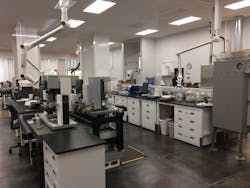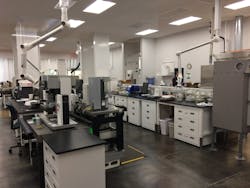Chemical Processing Notebook: AkzoNobel Reimagines the Post-Pandemic Supply Chain, Workforce
Come on, along
head for the mountains of Busch beer
head for the mountains
it’s cold, and it’s smooth, and it’s waiting for you
Come on, head for the mountains of Busch … beer
Remember that commercial? If not, you can view it on YouTube. When I watched those ads in the 80s, the only thing I ever thought about were mountains, cowboys … and drinking beer. That’s a little troubling since I was maybe 10 at the time. I certainly never thought about what gives those cans their shine.
That is, until I visited AkzoNobel’s Packaging Coatings research and development center in Strongsville, Ohio. During my tour, I got a firsthand look at how this multinational Dutch company develops packaging coatings that protect aluminum cans as well as coil coatings for building exteriors. The Strongsville laboratory opened in 2015, three years after the company divested its decorative paints business, including the Glidden brand.
A few weeks after my visit, AkzoNobel announced the launch of a next-generation coatings technology for beverage cans, driven by demand for packaging free of bisphenols A (BPA) and per- and polyfluorinated substances (PFAS). The company also said it was planning to build a new production plant in Spain to supply BPA-free coatings for the metal packaging industry in Europe, the Middle East and Africa.
What are some of the day-to-day challenges you face in your business?
For higher-end resins, whether it's intermediates or fillers or any type of third-party resins, lead times have been long. I mean, it was definitely normal to have what we call on-time in-full from our suppliers in the 50, 60 percentile range. One out of every two batches or one out every two orders came in on time. So I think COVID really challenged the supply chain teams more than anything else. And even though we're coming out of COVID now, we're still dealing with a very difficult workforce right now.
There are three jobs for every one person, so people get to pick what they want. Working from home really matters to people. The newer generation isn't as concerned, I would say, about the money. They truly want a work-life balance. So companies that can offer that are having less of a struggle hiring. For us, it depends on the region. Here, we've done pretty good at hiring. We have other locations that are much more challenging where the standard of living keeps going up. Typically, they’re the bigger cities like Nashville, Chicago, New York, even Charlotte. Those areas are getting very pricey from a living standpoint. That means wages need to go up to compensate for that.
For us, it comes down to building a structure and governance in our organization. No matter how much we invest in our sites and R&D labs, we're still a people company. You can have all the fancy robotics and things, but at the end of the day people make decisions, and we need as many good people as possible. So the recruiting and retention are big for us. And then working with our suppliers and understanding their challenges in supply chain and making sure that we can account for their variation that they have because it's not their fault that everybody's struggling. It's just the way of normal business now, so you need to be more flexible. Those are probably our two biggest challenges.
And I will say we do a lot of engagement with our people. We do an annual survey. I do a lot more one-on-ones with my people in my next tier than I used to do. I probably have 40-some one-on-ones every month, and it's really to make sure that I am staying connected to them and understanding what they are they thinking. What are their challenges? How do we help them? And, especially in this remote environment, I think it's important you find creative ways to stay attached.
How do you attract talent in this competitive environment?
I think it’s about being as creative as we can. The first thing is getting people to want to work here. The next challenge is how do you retain them? As we discussed, the newer generation not only wants work-life balance, but they also want opportunities. And so, you have to make sure you’re very clear and upfront with them and say, “these are the opportunities out there,” and then do they have a career path within the company? For me, I don't care if you have a manufacturing background, I've lately hired a lot of R&D people. A lot of them will tell you that I brought a lot of them in because it's about the skill sets you have; it’s not about whether you have experience making coatings or paint, right? We can teach people to do that. What you can't teach people is to be people managers, good people managers and leaders, and make good decisions.
Everybody's motivated by something different. Some people want to come in do the same thing every day. They want to get a paycheck at the end of every week, and they want to support their wife or kids or significant other at home. Other people, they don't have any of that. They want to support themselves and their hobbies. So knowing what they want and what motivates them, you better make sure that their path through the company lines up with that. And we need to be very flexible with that. And I think that's served us well in the last couple years coming out of COVID.
What about at the outset, though, just getting them in the door? You said you have to be somewhat flexible and creative around that.
People ask, “what is the work balance?” I mean, how many days a week do I need to be in the office? That's almost a question that they will ask us every time. Even in the job posting, we try to put in there flexible work hours. We know we're going to have to offer that. We also know tuition reimbursement, all that, that's a given anymore. And then it's also communicating that you're part of a larger team that will have other opportunities. We try to spell that out in the job postings.
I wanted to shift back to some of the supply chain issues you mentioned. You mentioned you were only getting 50% on-time delivery from suppliers. Was that during COVID?
That was during COVID, yeah. It is much higher now. I mean, we're still in the mid- to upper 60s. We still have our challenges, and we're working with our suppliers. A big thing you'll see all of us working on is what we call our business continuity plans or BCPs. And our business continuity plans used to be focused on having multiple sites to manufacture for our customers. But now, we're doing a lot more on our raw materials, and we have thousands of raw materials depending on the business we’re supporting. We are looking at having multiple sources of those raw materials. Back then (during COVID), you would design something with one raw material, one supplier, and when they had a hiccup, you just pass it along. You go to your customer and say, “Hey, we've got an issue. Can we work through this?” We're trying to get out of the firefighting mode. We all want to pat ourselves in the back when we firefight. We find a way to supply the customer, and the customer is happy, but that firefighting doesn't lead to long-term solutions and really setting ourselves up to win.
What about material pricing? How has that impacted your supply chain?
During COVID and even coming out of COVID prices went pretty high. All the raw material indexes were going through the roof. What we've seen over the last quarter or two, things are coming back down. We believe they'll steady out a little bit, but you just don't know, right? Certain ones, like solvents may be going one direction, and then resins may be going in another direction, but right now I think we're coming from an all-time high. We're going to level and plateau back out. I just hope it just stays consistent because there's always a lag when we buy raw materials, and the customer sees those price changes.
What impact is the regulatory environment having on your business?
Well, you see a lot of BPA non-intent (BPA-NI). So that's been the big focus for the last eight to 10 years, getting rid of bisphenol A in our products. And obviously formaldehyde, styrene, all these other raw materials are coming. Depending on which region you're in, it changes. Some regions are farther ahead, some countries are farther ahead. But you see a big push for BPA not-intent. Like our competition, we're all coming out with BPA-NI coatings, formaldehyde-free, styrene-free. And I think you've got to be prepared for what could be coming next, what's the next chemical concern that people don't want to have in their products. So you better have a pretty good technology roadmap at where you want to go. And it's not technology just for the application work, it's the technology for the regulatory piece.
Now, because a lot of our coatings, whether or not they're on metal roof or a Boeing or Airbus, they've got to last 20, 30 years, right? And they're in saltwater environments and high heat and cold and back and forth, especially on airplanes. So your product's got to last, but there's also chemicals concerns that people want to get away from. So in the next generation of materials coming out you need to think about both. That presents a lot of challenges. We're getting pushed to deliver both, and we've got a bunch of good products out there that we've been trialing, and the testing looks good.
We think we have a list of what people want in the future, but it changes, right? You just don't know. But you better have an R&D team that can adapt quickly and adjust, if needed.
Is that an area where you also need to collaborate with suppliers?
Constantly. When a new coating technology comes out and we’re working with our suppliers on what materials they have, we might need them to design a new resin, help us design a new resin or some other raw material for it. They might not actually have one that’s on the shelf that's the exact right fit for what we have. So then, we ask them to do some R&D work, and we do it with them. We've got a number of products going on right now where we're in that situation, and it's back and forth.
About the Author
Jonathan Katz
Executive Editor
Jonathan Katz, executive editor, brings nearly two decades of experience as a B2B journalist to Chemical Processing magazine. He has expertise on a wide range of industrial topics. Jon previously served as the managing editor for IndustryWeek magazine and, most recently, as a freelance writer specializing in content marketing for the manufacturing sector.
His knowledge areas include industrial safety, environmental compliance/sustainability, lean manufacturing/continuous improvement, Industry 4.0/automation and many other topics of interest to the Chemical Processing audience.
When he’s not working, Jon enjoys fishing, hiking and music, including a small but growing vinyl collection.
Jon resides in the Cleveland, Ohio, area.


